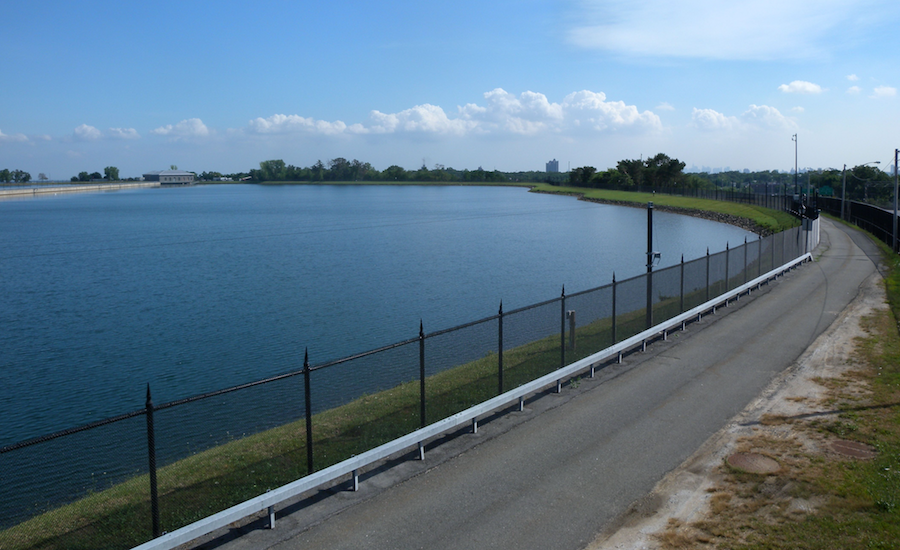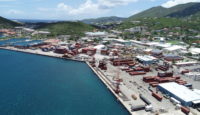New York City has agreed to a nearly $3-billion set of improvements to a nearby reservoir, including a cover, and to pay a $1-million fine to settle federal allegations that the city didn’t comply with Safe Drinking Water Act requirements, the Dept. of Justice says.
The agreement—spelled out in a consent decree filed on March 18 in federal district court in Brooklyn, N.Y., along with a federal lawsuit—deals with the Hillview Reservoir in Yonkers, N.Y., a short distance north of the Bronx. [View proposed consent decree here.]
The 90-acre reservoir provides as much as 1 billion gallons of water to the city per day. DOJ calls the facility “the last stop for drinking water before it enters the city’s water tunnels for distribution to city residents.”
According to DOJ, before water enters the reservoir, it is treated with chlorine and ultraviolet rays. But the department adds that the water in the uncovered reservoir can be re-contaminated by pathogens from birds and other animals as well as from viruses and the protozoa Giardia and Cryptosporidium. It says those organisms can cause potentially fatal gastrointestinal illnesses in humans.
As DOJ recounts the history, New York City has been required to cover the reservoir under a March 1, 1996, administrative order filed with New York State.
DOJ adds that under the federal Safe Drinking Water Act and implementing regulations, the city was obligated as of March 6, 2006, to install a cover for the reservoir by April. 1, 2009.
Then in May 2010, EPA filed an administrative order requiring the city to meet a series of milestones to cover the reservoir. The first such milestone was Jan. 31, 2017. DOJ said, “When the city failed to meet that date, this lawsuit followed.”
U.S. Environmental Protection Agency Administrator Andrew Wheeler said in a statement, “New York City failed to comply with Safe Drinking Water Act requirements that keep drinking water safe from harmful bacteria and viruses, even when it was under an order to do so.”
Ted Timbers, a spokesman for the New York City Dept. of Environmental Protection (DEP), said in an emailed statement, "New York City tap water is of the highest quality and it meets or exceeds all state and federal guidelines—more than 600,000 tests annually, including 36,000 at Hillview Reservoir, prove this.
Timbers added, "In the 1990s, EPA issued a national one-size-fits-all rule that requires a cover on even an extraordinarily well-protected asset like Hillview Reservoir and now New York City residents will spend $1.6 billion to build a redundant cover.
Costs and timetable
The $1.6-billion figure is the city's 2009 estimate for the cost of a concrete cover for the reservoir. The cost almost certainly has risen since that estimate was made.
Besides the cover, the consent decree mandates two other construction projects, which already were under way, though not under construction, before the agreement. One is an estimated $1-billion new underground aqueduct section between Kensico Reservoir in Valhalla, N.Y., and the Eastview ultraviolet treatment facility, in Mount Pleasant, N.Y.
The city's DEP announced plans for the Kensico-Eastview project last July and said at that time that design work for the project had already started. The department also said construction was expected to begin in 2023 on initial elements of the project, with construction of the tunnel itself to start in 2025.
The other project is an estimated $375-million program of what DOJ calls “extensive repairs” to the Hillview reservoir, including replacing sluice gates that regulate water flow and adding a new link between the reservoir and water distribution tunnels.
The work will span 30 years. According to DOJ, the reservoir repairs would be finished by 2033; the Kensico-Eastview connector would be completed in 2035.
The cover for the reservoir’s East Basin would be in full operation in 2042; the West Basin cover, the final element of the plan, would be fully operational seven years later.
Story updated on 3/20/19 to include full NYC Dept. of Environmental Protection statement, clarification of status of some projects and location of court where consent decree and lawsuit were filed.




